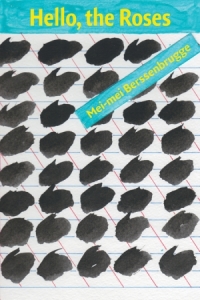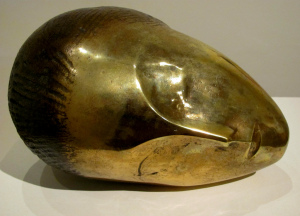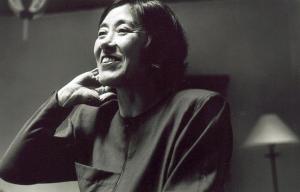By Jay Aquinas Thompson | Contributing Editor
I’m looking for new ways to make sense. Here’s Mei Mei Berssenbrugge:
A mobile relation to perception precedes affect.
Through it I experience from material a screen of surroundings I slice through, like sun through woods onto a golden pool.
A flash to other reality associates to other life, other environment also filled with precious belongings and loved ones, so immediate.
A world may be affirmed by the turn of a wing out of the corner of my eye.
Blue overhead deepens, the flex of an animal flank, the horizon line of the mountain darkens and lowers.
 These lines, from her latest and most celebrated volume, Hello, the Roses, are a puzzle: how are we to understand something so dense and so apparently cryptic? One of the oldest distinctions in lyric poetry is between the concrete and abstract: the sensory particular and the intellectual universal. The problem with this distinction, of course, is that sensory particulars magnetize and obsess us because our pattern-seeking intellect is drawn to them. Likewise, our intellectual abstractions are constituted from sensory phenomena—tastes, sights, savors, sounds, contacts—that begin to accrete in us at birth (which is our first experience of unlikeness, and hence our first experience).
These lines, from her latest and most celebrated volume, Hello, the Roses, are a puzzle: how are we to understand something so dense and so apparently cryptic? One of the oldest distinctions in lyric poetry is between the concrete and abstract: the sensory particular and the intellectual universal. The problem with this distinction, of course, is that sensory particulars magnetize and obsess us because our pattern-seeking intellect is drawn to them. Likewise, our intellectual abstractions are constituted from sensory phenomena—tastes, sights, savors, sounds, contacts—that begin to accrete in us at birth (which is our first experience of unlikeness, and hence our first experience).
To state the problem differently: Berssenbrugge knows as well as, say, Brancusi that all thought is embodied, and that all abstraction is filtered and understood, in some way, through experience. This means there’s no such thing as a “pure” image in Berssenbrugge’s four decades of poetry. But that’s not all in her work that confounds the old-fashioned distinctions of lyric writing. There’s a belief, as old as Wordsworth’s Prelude, that the lived-in particular emerges from the poet’s experience—a heartbeat of time the poet shares with the subject of her attention—but the abstraction breaks in upon her from outside. Early in The Prelude, Wordsworth, rowing across a quiet lake, has the eerie sensation of a mountain pursuing him:
…With trembling oars I turned,
And through the silent water stole my way
Back to the covert of the willow tree;
There in her mooring-place I left my bark,
And through the meadows homeward went, in grave
And serious mood; but after I had seen
That spectacle, for many days, my brain
Worked with a dim and undetermined sense
Of unknown modes of being; o’er my thoughts
There hung a darkness, call it solitude
Or blank desertion. No familiar shapes
Remained, no pleasant images of trees,
Of sea or sky, no colours of green fields;
But huge and mighty forms, that do not live
Like living men, moved slowly through the mind
By day, and were a trouble to my dreams.
 Those later “mighty forms” are deliberately abstract: they are ghostly outside presences, haunting the soul of the young poet, overmastering and displacing the “familiar shapes” of his earlier experience. And so it goes in most subsequent lyric poetry. A rhapsody emerges, a transcendent feeling gathering above the poem’s particulars and then announcing in a rush some greater truth to the poet: “Suddenly I realize / That if I stepped out of my body I would break / Into blossom.”
Those later “mighty forms” are deliberately abstract: they are ghostly outside presences, haunting the soul of the young poet, overmastering and displacing the “familiar shapes” of his earlier experience. And so it goes in most subsequent lyric poetry. A rhapsody emerges, a transcendent feeling gathering above the poem’s particulars and then announcing in a rush some greater truth to the poet: “Suddenly I realize / That if I stepped out of my body I would break / Into blossom.”
But what I love about Mei Mei Berssenbrugge’s poetry is that it does, essentially, the opposite. Her poems’ ground is not experience but abstraction, a dense idea delivered in matter-of-fact, prosey lines; what breaks in upon her consciousness is not epiphany, but image. Here’s a bit of “Daughter,” from Four Year Old Girl.
How mystifying the substantive time is, which had been the transcendental signified!
Cherry blossoms precede coppery, energetic leaves. A petal falls on a branch. Leaf opens
beside it. What I thought I could lose of a person and what I thought I had lie next to each other,
repeating, so the time in which you know her is a foliage during time and folds over on itself,
hill filling with dogwood, tree of sky turning rose.
What a way to make sense! No thundering voice to awe the reader, no bow tied around the end of the sentiment. The “tree of sky” and falling petal aren’t squeezed into mere metaphor, but are instead vital units pushing back against and enlivening the poet’s highly abstract first thought, suggesting the extent to which our experience of “the transcendental signified” is composed of such particulars to begin with. And even the ravishingly pretty stuff refuses resonance: Berssenbrugge seems tempted neither by absolute statement or by some grand musical interplay between sentence and line.
 I can’t think of another poet who works quite this way. Marianne Moore’s sentences are similarly scrupulous and bumpy, but Moore is analytical and reserved where Berssenbrugge’s work overflows with compassion, grief, and gratitude (her selected poems is called I Love Artists). Barbara Guest—an important teacher of Berssenbrugge’s—grants a similar power to her aesthetic abstractions, but Berssenbrugge retains none of Guest’s reticence.
I can’t think of another poet who works quite this way. Marianne Moore’s sentences are similarly scrupulous and bumpy, but Moore is analytical and reserved where Berssenbrugge’s work overflows with compassion, grief, and gratitude (her selected poems is called I Love Artists). Barbara Guest—an important teacher of Berssenbrugge’s—grants a similar power to her aesthetic abstractions, but Berssenbrugge retains none of Guest’s reticence.
Here, from Hello, the Roses, are a few lines from “The Lit Cloud”:
Sun shines through woods as I walk, angles of light in air, like fault lines in the crystal.
Its circular movement is a linking of threadlines, reflecting into being something that was an idea, an image; then everything around becomes a reflector in gold of time passing as motion manifesting.
Spirit refers to this cloud image or scrim awareness within what is forming.
Though Berssenbrugge’s declaratives suggest the structure of an essay, her poems don’t follow a throughline of argument. Rather, they seem to expand outward from a first stimulus, as each circular ripple of water contains all those that will follow it. Just as her vibrant and even pushy images tell the reader something about abstract thought, this sense of self-embracing and cyclical reflection tells the reader something about Berssenbrugge’s sense of time. Her poems—especially in Four Year Old Girl and the balanced and elegent Roses—seem difficult only until you realize that they keep explaining to the reader how to read them: “A world may be affirmed,” she tells us plainly, “by the turn of a wing.”
—
photo credits: Constantin Brancusi (license) and EPC
